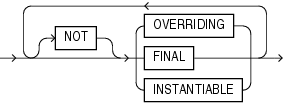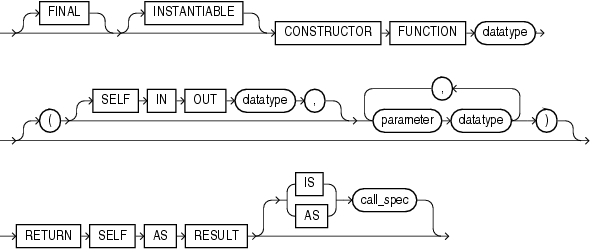Element Specification
An element specification specifies each attribute of the ADT.
An element specification can appear in the following SQL statements :
Syntax
element_spec ::=
( subprogram_spec ::= , constructor_spec ::=, map_order_function_spec ::=, restrict_references_pragma ::=)
inheritance_clauses ::=
subprogram_spec ::=
function_spec ::=
map_order_function_spec ::=
Semantics
element_spec
inheritance_clauses
Specifies the relationship between supertypes and subtypes.
[NOT] OVERRIDING
Specifies that this method overrides a MEMBER method defined in the supertype. This keyword is required if the method redefines a supertype method. Default: NOT OVERRIDING.
[NOT] FINAL
Specifies that this method cannot be overridden by any subtype of this type. Default: NOT FINAL.
[NOT] INSTANTIABLE
Specifies that the type does not provide an implementation for this method. Default: all methods are INSTANTIABLE.
Restriction on NOT INSTANTIABLE
If you specify NOT INSTANTIABLE, then you cannot specify FINAL or STATIC.
See Also:
subprogram_spec
Specifies a subprogram to be referenced as an ADT attribute. For each such subprogram, you must specify a corresponding method body in the ADT body.
Restriction on subprogram_spec
You cannot define a STATIC method on a subtype that redefines a MEMBER method in its supertype, or vice versa.
MEMBER
A subprogram associated with the ADT that is referenced as an attribute. Typically, you invoke MEMBER methods in a selfish style, such as object_expression.method(). This class of method has an implicit first argument referenced as SELF in the method body, which represents the object on which the method was invoked.
See Also:
STATIC
A subprogram associated with the ADT. Unlike MEMBER methods, STATIC methods do not have any implicit parameters. You cannot reference SELF in their body. They are typically invoked as type_name.method().
Restrictions on STATIC
-
You cannot map a
MEMBERmethod in a Java class to aSTATICmethod in a SQLJ object type. -
For both
MEMBERandSTATICmethods, you must specify a corresponding method body in the type body for each procedure or function specification.
See Also:
procedure_spec or function_spec
Specifies the parameters and data types of the procedure or function. If this subprogram does not include the declaration of the procedure or function, then you must issue a corresponding CREATE TYPE BODY statement.
Restriction on procedure_spec or function_spec
If you are creating a subtype, then the name of the procedure or function cannot be the same as the name of any attribute, whether inherited or not, declared in the supertype chain.
return_clause
The first form of the return_clause is valid only for a function. The syntax shown is an abbreviated form.
See Also:
"Collection Method Invocation" for information about method invocation and methods
constructor_spec
Creates a user-defined constructor, which is a function that returns an initialized instance of an ADT. You can declare multiple constructors for a single ADT, if the parameters of each constructor differ in number, order, or data type.
-
User-defined constructor functions are always
FINALandINSTANTIABLE, so these keywords are optional. -
The parameter-passing mode of user-defined constructors is always
SELFINOUT. Therefore you need not specify this clause unless you want to do so for clarity. -
RETURNSELFASRESULTspecifies that the runtime type of the value returned by the constructor is runtime type of theSELFargument.
See Also:
Oracle Database Object-Relational Developer's Guide for more information about and examples of user-defined constructors and "Example 15-34"
map_order_function_spec
You can declare either one MAP method or one ORDER method in a type specification, regardless of how many MEMBER or STATIC methods you declare. If you declare either method, then you can compare object instances in SQL.
If you do not declare either method, then you can compare object instances only for equality or inequality. Instances of the same type definition are equal only if each pair of their corresponding attributes is equal. You must not specify a comparison method to determine the equality of two ADTs.
You cannot declare either MAP or ORDER methods for subtypes. However, a subtype can override a MAP method if the supertype defines a NOT FINAL MAP method. A subtype cannot override an ORDER method at all.
You can specify either MAP or ORDER when mapping a Java class to a SQL type. However, the MAP or ORDER methods must map to MEMBER functions in the Java class.
If neither a MAP nor an ORDER method is specified, then only comparisons for equality or inequality can be performed. Therefore object instances cannot be ordered. Instances of the same type definition are equal only if each pair of their corresponding attributes is equal. No comparison method must be specified to determine the equality of two ADTs.
Use MAP if you are performing extensive sorting or hash join operations on object instances. MAP is applied once to map the objects to scalar values, and then the database uses the scalars during sorting and merging. A MAP method is more efficient than an ORDER method, which must invoke the method for each object comparison. You must use a MAP method for hash joins. You cannot use an ORDER method because the hash mechanism hashes on the object value.
See Also:
Oracle Database Object-Relational Developer's Guide for more information about object value comparisons
MAP MEMBER
Specifies a MAP member function (MAP method) that returns the relative position of a given instance in the ordering of all instances of the object. A MAP method is called implicitly and induces an ordering of object instances by mapping them to values of a predefined scalar type. PL/SQL uses the ordering to evaluate Boolean expressions and to perform comparisons.
If the argument to the MAP method is NULL, then the MAP method returns NULL and the method is not invoked.
An object specification can contain only one MAP method, which must be a function. The result type must be a predefined SQL scalar type, and the MAP method can have no arguments other than the implicit SELF argument.
Note:
If type_name is to be referenced in queries containing sorts (through an ORDER BY, GROUP BY, DISTINCT, or UNION clause) or containing joins, and you want those queries to be parallelized, then you must specify a MAP member function.
A subtype cannot define a new MAP method, but it can override an inherited MAP method.
ORDER MEMBER
Specifies an ORDER member function (ORDER method) that takes an instance of an object as an explicit argument and the implicit SELF argument and returns either a negative, zero, or positive integer. The negative, positive, or zero indicates that the implicit SELF argument is less than, equal to, or greater than the explicit argument.
If either argument to the ORDER method is NULL, then the ORDER method returns NULL and the method is not invoked.
When instances of the same ADT definition are compared in an ORDER BY clause, the ORDER method function is invoked.
An object specification can contain only one ORDER method, which must be a function having the return type NUMBER.
A subtype can neither define nor override an ORDER method.
Restriction on map_order_function_spec
You cannot add an ORDER method to a subtype.
restrict_references_pragma
Deprecated clause, described in "RESTRICT_REFERENCES Pragma".
Restriction on restrict_references_pragma
This clause is not valid when dropping a method.







